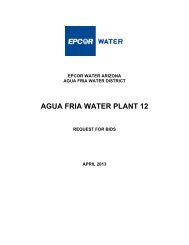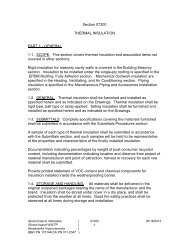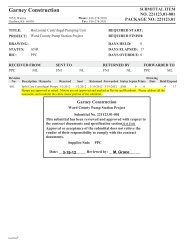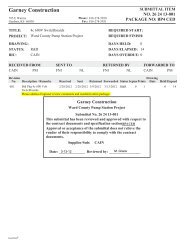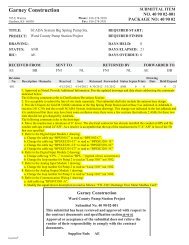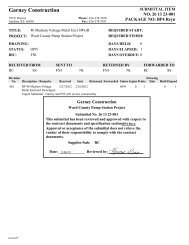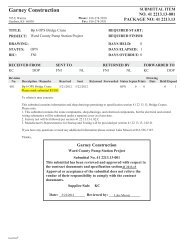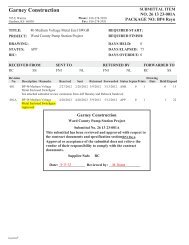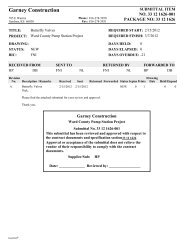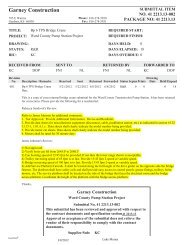33 12 16.26 - 001-A - Response AAN-ANR Butterfly Valves - Garney ...
33 12 16.26 - 001-A - Response AAN-ANR Butterfly Valves - Garney ...
33 12 16.26 - 001-A - Response AAN-ANR Butterfly Valves - Garney ...
Create successful ePaper yourself
Turn your PDF publications into a flip-book with our unique Google optimized e-Paper software.
Control specification<br />
Interlocks<br />
External hardwired interlocks for<br />
opening, closing or both directions<br />
can be configured to inhibit local and<br />
remote operation until the external<br />
contacts are made. Interlock circuits<br />
may be added with any of the remote<br />
control circuits. The interlock inputs<br />
operate from a separate common<br />
allowing for isolation between the<br />
safety system and operation control<br />
system. Refer to page 15 for standard<br />
interlock circuit options.<br />
Conditional control<br />
For applications where a high level of<br />
control integrity is required the IQ can<br />
be configured for “conditional control”.<br />
In this mode, operation is conditional<br />
on two discrete signals being<br />
applied. Looking at an example of a<br />
“close valve” command, by applying a<br />
signal to the “remote close input” and<br />
“close interlock input” simultaneously<br />
the actuator will operate and close the<br />
valve. If only one signal is applied or a<br />
signal is lost, the actuator will failsafe<br />
by staying put or stopping. When<br />
conditional remote control is configured<br />
the interlock inputs are not<br />
required for local operation.<br />
Remote control options<br />
Analogue Control -<br />
Folomatic Option<br />
The IQ Folomatic proportional<br />
controller enables the actuator to<br />
automatically position a valve in<br />
proportion to an analogue current,<br />
voltage or potentiometric signal. A<br />
signal derived from the actuator noncontacting<br />
position sensor is<br />
electronically compared with a signal<br />
proportional to the input signal. The<br />
difference between them (error)<br />
triggers the open or close contactor<br />
via logic circuits to drive the actuator<br />
in the direction that will cancel the<br />
error. Valve position is therefore<br />
automatically adjusted in proportion to<br />
analogue signal. Unnecessarily<br />
frequent operation can be prevented<br />
by the adjustable Folomatic deadband<br />
and the Motion Inhibit Timer features.<br />
Positioning can take place over the<br />
whole valve stroke or if required, a set<br />
portion of stroke. By incorporating a<br />
remote manual/auto selector,<br />
proportional control can be overridden<br />
allowing standard remote control to<br />
take place when manual intervention<br />
is required.<br />
Application<br />
Reversing motor-driven electromechanical<br />
actuators are suitable for<br />
proportional control in automatic<br />
control loops in which the system rate<br />
of change is relatively slow, and high<br />
accuracy continuous modulation is not<br />
essential; level controls in water and<br />
sewage treatment plants are typical<br />
applications. Motor operated<br />
regulating valves and sluice gates are<br />
driven through nut and screw or<br />
wormgear mechanisms which must be<br />
self-locking and are therefore<br />
mechanically inefficient. Frequent<br />
operation will cause rapid wear of<br />
these components. The control<br />
systems should therefore be designed<br />
to avoid this. Stem nut life will be<br />
maximised if the valvemaker uses a<br />
stem thread with a lead of one third<br />
of the diameter.<br />
Standard IQ actuators are suitable for<br />
regulating applications requiring up to<br />
60 starts/hour providing the average<br />
torque required by the valve in mid<br />
stroke does not exceed <strong>33</strong>% of the<br />
rated torque of the selected actuator.<br />
Where modulating applications require<br />
increased rates of starts per hour, the<br />
IQM and IQML actuator ranges can<br />
be operated up to a rate of <strong>12</strong>00<br />
starts/hour and include configurable<br />
DC injection motor breaking to reduce<br />
overrun.<br />
For more information please refer to<br />
publication E410E.<br />
Accuracy<br />
The Folomatic positioner accuracy is<br />
1%. Because of the backlash in nuts,<br />
screws and gearing of industrial valves,<br />
overall accuracy may not be quantified<br />
prior to the valve and actuator being<br />
put into service. To optimise positional<br />
accuracy, actuator output speeds<br />
should be kept as low as practicable.<br />
Rotork do not recommend output<br />
speeds in excess of 29rpm. The<br />
maximum signal change required to<br />
cause response in the same direction<br />
(ie. not through deadband) is 1%.<br />
Output resolution will be a function of<br />
actuator speed and valve stem thread<br />
or gearing backlash.<br />
Folomatic Configuration<br />
The Folomatic can be configured to<br />
suit signals within the following<br />
ranges:<br />
Analogue signals/input impedance:<br />
0-5mA/1k ohm 0-5V/1M ohm<br />
0-10mA/500 ohm 0-10V/78k ohm<br />
0-20mA/250 ohm 0-20V/52k ohm<br />
4-20mA/250 ohm<br />
Position corresponding to low<br />
input signal:<br />
Closed limit, or percentage open, or<br />
Open limit.<br />
Position corresponding to high<br />
input signal:<br />
Closed limit, or percentage open, or<br />
Open limit.<br />
Deadband:<br />
0-9.9% of travel between Open and<br />
Closed limit positions.<br />
Motion inhibit time:<br />
2-99 sec between actuator movements.<br />
Action on loss of input signal:<br />
Stay-put, move to high or low signal<br />
position. Available for minimum set<br />
“low” signal of 0.5mA. <strong>Response</strong> on<br />
loss of signal will occur if signal falls<br />
below 50% of set “low” signal.<br />
Connections<br />
For analogue control connections,<br />
and analogue control connections with<br />
remote manual override, refer to<br />
page 18.<br />
8



